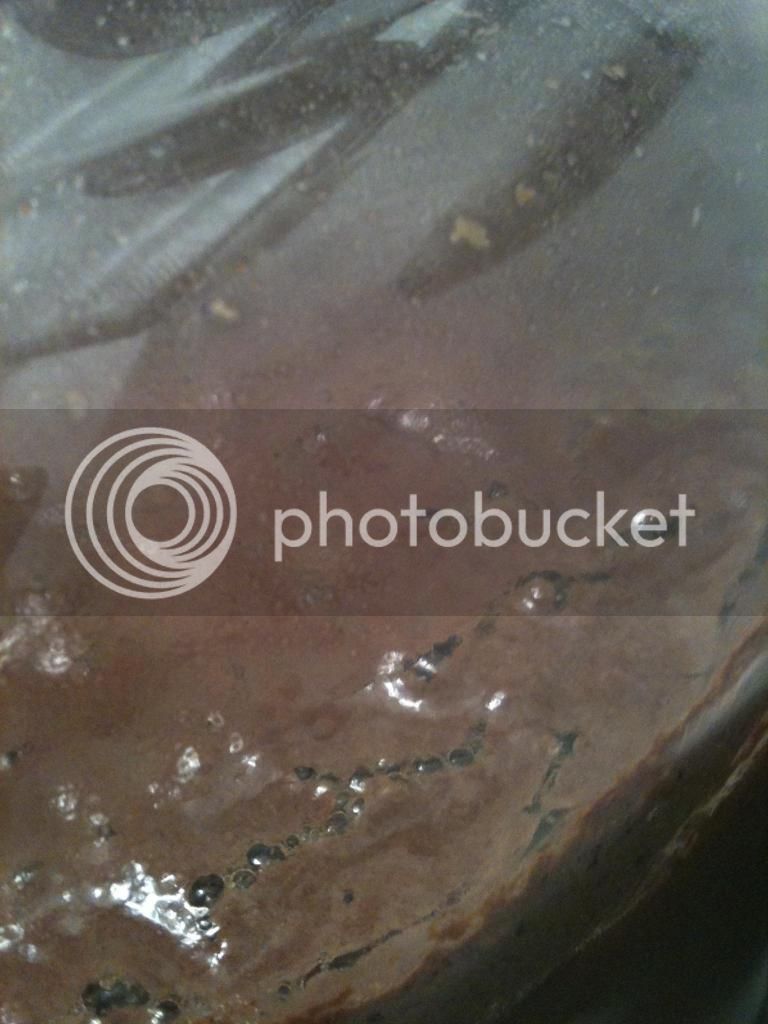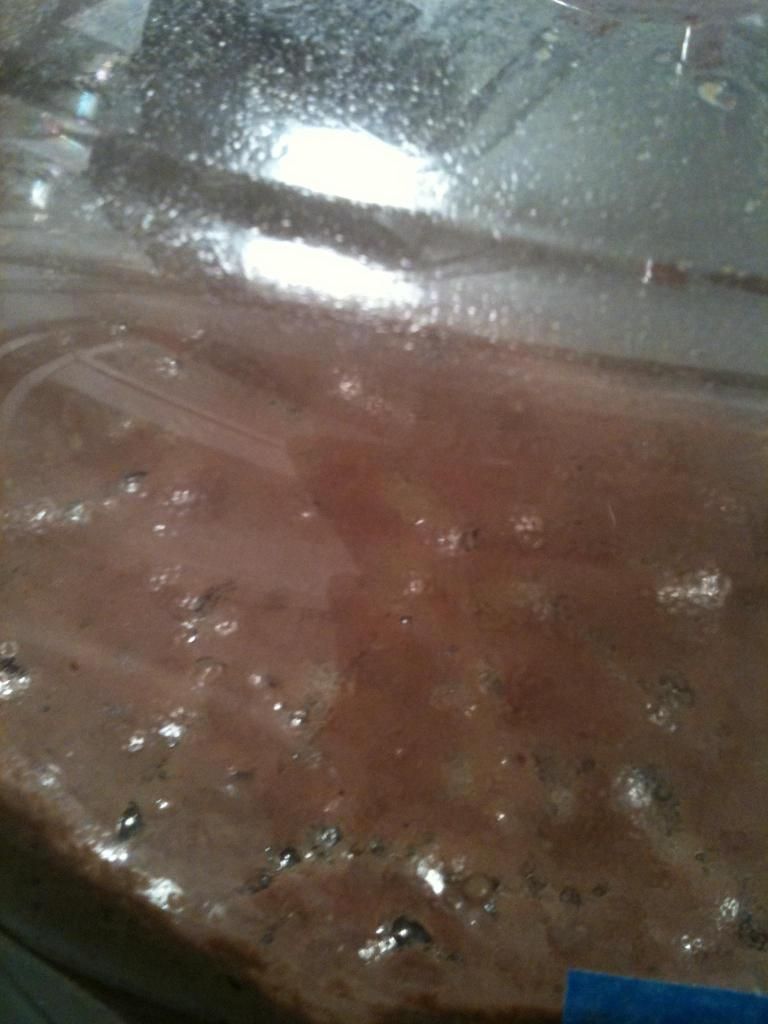I'm thinking your still fermenting is whats going on here. The Krausen should have fallen all the way through to the trub.
Well, here is what it looks like after 3 more days. Any ideas?


I'm thinking your still fermenting is whats going on here. The Krausen should have fallen all the way through to the trub.

Well, here is what it looks like after 3 more days. Any ideas?
I think i got my first infection on my second batch. Here is a picture of it. What do you think? Lactobacillus or just mold?

Lil bit o bugs.
Nice and clear though!

Looks like your still fermenting.. What were your gravity readings?
That said some bigger than normal bubbles there.. but that could be from something in the beer itself and completely fine. because overall it just looks like bubbles.
I don't see any of the plaques and scum you normally see in an bacteria infection.
I think your fine.
















I think that's just leftovers and oils from dry hopping. Could be wrong..
Taste it and if its good its good..
No matter what "infection" or "Junk" you get in your beer. Nothing that can hurt you grows in beer. Just things to make you go EWWWWW when you look at it or make the beer taste off or sour.
So if it tastes good, bottle it and forget what you saw floating in it.
Could be scum from something in the beer itself.. While the plaque looks like Lacto, there are no bubbles or strings running through it.
Style of beer ?
Did you get a Krausen or not..?
Is this in the primary or secondary..?
Put anything in the secondary for it to sit on..?
That's a 7 month old sour saison. What you see on top is a young pediococcus pellicle forming, on bottom is what's left of the lacto infection and the brett after the other bugs have had their way.

It's supposed to be a Belgian Ale (Specialty). I've got a Krausen at first 5 days or so, and had SG reading after this. I didn't rack it to a secondary fermentor, it's sitting at same bucket for 2 weeks now. And no, nothing added to the fermentor (at least not intentionally)
It seems to be expanding to cover more of the surface. And when the bubbles get giant, they do burst. It started at OG 1.047 and was at 1.010 when I transferred. These are on target with the BB recipe pamphlet.
It might be nothing. There is a lot of head-space in the carboy and there might not have been enough CO2 in suspension when transferred. It might be full of air.
The mad scientist in me wants to let it go and study it for a couple of more weeks. But the beer drinker in me is stronger (and it still smells great) - and so it heads to the bottles later today.
I am tempted to dose the surface with StarSan Idophor.
I'll follow-up after with notes from the bottles in a week or so. I have seen a number of posts on various boards (around page 85 here) that show this characteristic in secondary. Thank you for the help and comments.
Post Script at bottling: The gravity measurement at bottling was down to 1.005, so it did ferment some more during the 5 days in secondary. (22 days from pitch to bottle) The taste at this point is "Hen's Toothy".
I can't say for certain.. but I do think its probably lacto or mold.. hard to tell.. I would test it and see what it tastes like, If it tastes good bottle from under it or rack to secondary. I have heard of good results if you have a light sourness, to rack with a bit of honey and/or dry hopping.

I took a sample today. The SG dropped a point from 1.008 to 1.007. Though it doesn't smell fruity as it was at first sample, it didn't tasted sour either. It didn't tasted amazing, but it didn't tasted bad either.
Any ideas for completely avoid this stuff to get into my bottles? I took the sample from beneath, but still got something of it.
this has carried on from my last post. Not sure if that was infected, bottled it anyway. Bleached the **** out of my equipment and transferred my Saison. This is it after 6 days, OG: 1060, FG: 1002. I'm figuring it is C02 trapped under some layer on the surface, but that layer shouldn't be there in the first place??



I'm trying to figure out where it is coming from because I've never had problems with infections thus far (over 30 extract and 15 grain brews). I will ditch the plastic tubing but I'm not keen to buy another glass carboy. Surely the glass can be cleaned better than plastic ever can?
This is my third batch, a chocolate stout, on day 3 of fermentation. Kraussen was there for day 2 and day 3 morning. However, when I came home from work the kraussen settled down and I just see these weird bubbles popping on the surface of whats left of the kraussen. I haven't experienced this before because my first two batches had kraussen from hell pouring out of the blowoff (probably due to high ferm temps at around 72) so thats what i was kinda used to. But this batch was the first that I used with optimal temps in a fridge with a controller so I am kinda wondering if this is normal.
I'm trying to figure out where it is coming from because I've never had problems with infections thus far (over 30 extract and 15 grain brews). I will ditch the plastic tubing but I'm not keen to buy another glass carboy. Surely the glass can be cleaned better than plastic ever can?
Glass, hard plastic (What I use for my fermentor), stainless steel (what I use for secondary) all clean well.. use the Iodine based sanitizers.
You could have simply laid a spoon, or something on the counter and picked it up. Lacto is everywhere. From a few drops of spilled milk on a counter to the air or in the sink. Often even if your perfectly clean you can get it, I would venture to say even on clean surfaces, it can exist in small amounts but the yeast beat it and it never grows enough for anyone too see.
In your case, a bad tube could easily be the culprit. I pour about 10-12 drips or more of iodine in my tubes, fill with a little water and slosh the stuff in the tubes, and then wipe with it rag I soaked in a iodine and water solution.
So far so good.. although in my bottled octoberfest, I am seeing "grossness" in them.. I am crossing my fingers that what I see in a few of the bottles is crap I didn't get out good enough.

Hi I'm about to brew my first batch of beer and I am attempting to harvest the yeast from a bottle of westmalle. I put the tail end of the bottle into some LME solution, and shook it up real good and nothing happened. I continued to shake it occasionally for the next 3-4 days and still nothing happened. Then all of a sudden today this stuff popped up. Is this an infection or just the yeast?

btw there are tiny little black dots on the top of a couple of those white mounds that you cannot see in the picture.
If that's just a harvest attempt, chuck it.
Try using something glass, and with a little less surface area for your first step up. A mason jar with tin foil over the top works well.
So that's not what yeast is supposed to look like? I honestly have no idea what the first signs of yeast rafts or krausen in a starter are supposed to look like.
This is my third batch does this look normal? It's been in primary for a week. On my first two beers I didn't notice anything like that. It smells great I have not tasted yet.